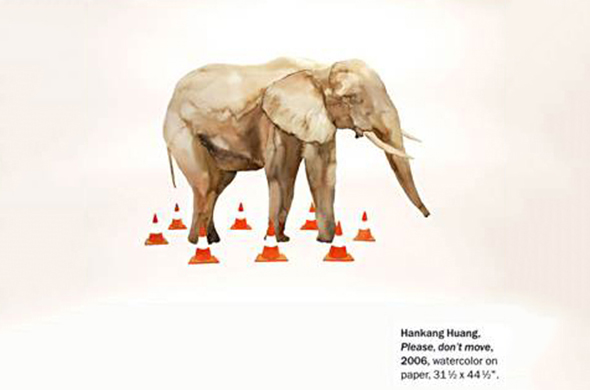
There''''s a delicacy of handing in Chinese artist Hankang Huang''''s watercolors that is clearly derived from his traditional training at the Art college of Suzhou University. In A problem of self , 2005, for example, the black strokes that form the stripes of tigers, the faint outlines that mark the limits of their bodies, and the way that they stand on the open expanse of white paper are all consistent with pictorial conventions that date back many centuries. But the image is witty as well as formally refined, the title suggesting the conceptual character of the work: The tigers move in opposite directions, but their tails are tied together in a tug-of-war that suggests a conflict between the two halves of divided self, for the tigers are mirror images of one another.
Their psychological implications aside, the tigers might also symbolize China itself, a nation drawn irresistibly to the modern but still bogged down in the premodern - as the helicopter stuck in the barren tree in Intentional or Unintentional, 2006, suggests.Huang pictures numerous contradiction: In Please, don''''t move, 2006, an elephant, an ancient means of transportation, stands amid a field of traffic cones, while in Exhale and Inhale, 2005, a gas mask attached to a vacuum cleaner suggests an elephant head. There are also erotic allegories, most notably Run Into, 2005, but one wonders if this is not also a political allegory, the helpless Caucasian beauty symplolizing the vulnerable West and the roaring beast threatening her the newly powerful China.
The most startling image in the exhibition appears in On Evolution, 2005. It''''s composite of a rabbit skeleton and a human skull, a hybrid that suggests we haven''''t evolved as far as we like to think. Whatever our country of origin, however big our brains, humans remain predatory animals. Recent world affairs have certainly borne out Marxist historian Eric Hobsbawm''''s argument that barbarism is increasing rather than decreasing. On Evolution is a memento mori for human civilization.
All of Which is to say that while Huang''''s watercolors attain an ambrosial lightness of spirit by way of lyric nuance, they tend also to be full of macabre meaning. The most seemingly innocent scenes are fraught with unpleasant import. In To See the Beyond, 2005, for example, a dog, dressed in a colorful outfit, is suspended by its collar from thethin branch of leafless tress similar to the one in Intentional or Unintentional. The viewer is caught between trepidation about the dog''''s strangling and anxiety over the imminent snapping of the branch. In Huang''''s pictures, nature tends to appear subdued, dazed, or inert. The lion is menacing, but however loud he roars, he doesn''''t stir, doesn''''t attack the fallen woman. He''''s as peculiarly incapacitated as the "paper tigers" in A problem of Self. Mao called America a paper tiger, but China may also be one --- so full of self- destructive contradictions that it threatens to render itself impotent.
Most of Huang''''s watercolors are the same size, and, arranged sequentially, suggest a shifting stream of consciousness, with unchanging insidious significance. The figures, whether animal , vegetable, or human, are self-contained and adrift in a hermetic void---the whiteness of the paper. It is Huang''''s articulation of this void---his ability to give it an autonomous epic presence and spatial intensity---that is the most masterful aspect of his work; more than the figures themselves, it is this featureless emptiness that fills the
viewer with disquiet.
ARTFORUM 杂志 2006 9月
批评家:Donald Kuspit




























